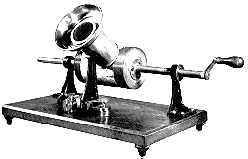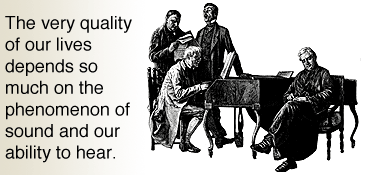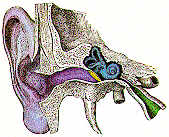 |

Explains just about all you need to know about Cassette Duplication in a Fun and Informative way!
|
IN THIS ISSUE:
 |
 |
|
|

 LITTLE OVER A CENTURY AGO, all sound was live. Once produced, it was gone with the echo. Then in 1877 the world's first recorded phrase, "Mary had a little lamb," was captured in time. Although this recording, made by Edison on his newly invented phonograph, was barely audible and scratchy, it was hailed as the "miracle of the 19th Century." Soon Edison's invention was to record everything from coronet solo's to arias for an ever ecstatic public. With it, man had begun to create a treasury of sound. With LITTLE OVER A CENTURY AGO, all sound was live. Once produced, it was gone with the echo. Then in 1877 the world's first recorded phrase, "Mary had a little lamb," was captured in time. Although this recording, made by Edison on his newly invented phonograph, was barely audible and scratchy, it was hailed as the "miracle of the 19th Century." Soon Edison's invention was to record everything from coronet solo's to arias for an ever ecstatic public. With it, man had begun to create a treasury of sound. With  improvements in the "talking machine" and the development of an electroplating process — enabling mass production of records from a single disc — an industry was born. improvements in the "talking machine" and the development of an electroplating process — enabling mass production of records from a single disc — an industry was born.
In the early '20s the "talking machine soon made way for wonderful new invention — the radio. The technology that made radio possible was applied to recording with revolutionary results.
Unlike the phonograph that mechanically transferred sound waves into patterns or impressions on tinfoil or wax, this new technology used microphones to convert sound into electrical currents. These signals were then amplified through a series of vacuum tubes. However, recordings were still made on discs with sound represented as bumps on a groove.
Moving ahead to the 1940's we come upon a major breakthrough — magnetic recording. Although invented 1898 by a Dutch engineer, it didn't become a viable medium until it was perfected in Germany during World War II. It quickly became the standard recording medium because of its high-fidelity, convenience and ease of editing.
In 1966 Phillips introduce the compact cassette. At first applauded only for its convenience and not its audio quality, it was primarily used as a dictation medium. It wasn't until developments in manufacturing made the cassette reliable enough to replace the eight-track and the advent of the Walkman, that it was to become the ultimate choice for portable recorded material in our highly mobile society.
A NEW STANDARD
The audio cassette. By 1983 it surpassed all other mediums as the preferred medium for the distribution of sound recordings. As its popularity grows and with the higher standards of a more sophisticated public (created by the advent of the digital revolution) today's audio cassettes must be better than ever. For Cassette Works this means tighter quality control and higher standards.
Unfortunately, this is no easy task. Quality is something that is built into a product — a philosophy of operation. Each phase of the high speed duplication process interacts with the other requiring constant monitoring at each step in order to keep the product consistent from piece to piece. Clearly, we must look at this as a total system.
HIGH SPEED DUPLICATION
To a casual observer in our plant, it might seem like overkill to have such relatively massive equipment to place sound on a tape that is only about an eighth-of-an-inch wide. The key reason is simply — better control. The newest technologies have brought us automation and the ability of our equipment to monitor or to be monitored. These are key to dramatically improving our quality control process.
As we stated, the final cassette product is the culmination of a series of elements ranging from the studio master, the equalization or production master, the speed of the duplicator and its circuitry, the cassette housing or shell, and the tape itself, to name only a few. Each element has distinctly different characteristics that play an important role as to how that finished cassette is going to sound in the ears of the listener. Using good tape is not enough to guarantee a good copy. At Cassette Works, we use the synergy of these elements working together as a total system, to create a consistently superior product for you.
All of us are struck by the importance of sound each and every day. That's why we work to develop or implement ways to heighten the power and beauty of sound. All of our equipment has been especially has chosen for their sonic characteristics. We employ new mastering and duplication techniques to meet the highest standards of frequency response and sound reproduction. In just the last year, new formulations and advancements in equipment technology, have improved high speed duplication to the point where we are now able to produce extremely high quality cassettes in mass quantities. All of our equipment has been especially has chosen for their sonic characteristics. We employ new mastering and duplication techniques to meet the highest standards of frequency response and sound reproduction. In just the last year, new formulations and advancements in equipment technology, have improved high speed duplication to the point where we are now able to produce extremely high quality cassettes in mass quantities.
This extreme focus on sound is just one indication that the existence of our culture depends on the existence of sound. Whether it be the sound of someone talking, a musical performance, or just simply noise, sound is an essential part of our lives no matter who we are, where we are, or what we do. The very quality of our lives depends so much upon the phenomenon of sound and our ability to hear.
Today, sound can be played within ways we never thought possible. We can equalize it, mix, it, squeeze it, digitize it. We can drive it to higher peaks of intensity and greater levels of quality than ever before.
Here at Cassette Works, we are dedicated to the quality of sound. We work hard to capture all the magic and subtleties of recorded sound — for you.
|

 HE EAR IS MAN'S MOST SENSITIVE ORGAN. In the ear are fluid-filled cavities with sensory cells that are acutely sensitive to changes in air pressure caused by sound vibrations. So sensitive in fact, that if they were any more sensitive to loudness, we would hear the constant roar of air pressure fluctuations caused by the random movement of air molecules. Loudness is measured in units called decibels. HE EAR IS MAN'S MOST SENSITIVE ORGAN. In the ear are fluid-filled cavities with sensory cells that are acutely sensitive to changes in air pressure caused by sound vibrations. So sensitive in fact, that if they were any more sensitive to loudness, we would hear the constant roar of air pressure fluctuations caused by the random movement of air molecules. Loudness is measured in units called decibels.

Another way of measuring the sensitivity of the ear relates to frequency response. As you know, sound travels in waves. The length of the sound wave — the distance between one peak of the wave to the next — is stated in terms of frequency, or how many consecutive wave peaks per second. The more peaks or vibrations per second the higher the sound. Conversely, the fewer the vibrations per second, the lower the sound.

The frequency of these various sounds is measured in units called Hertz, abbreviated Hz.
A healthy young person can hear waves that vibrate or sounds from as low as 20 up to 20,000 Hertz. This range assumes ideal conditions — perfect hearing and no distracting noises. However, few adult humans can hear sounds much over 10,000 Hz. This is because as we age, the limit of our ability to hear decreases down to only about 5000 Hertz in people over age 60.
In addition, our constant exposure to loud noises limits our ability to hear. Normal conversation takes place at about 50 to 60 decibels, but constant exposure to sound of only 80 decibels can cause hearing loss. Naturally, the louder the sound the less time it takes for damage to occur. (See We Want You Listening For A Lifetime)
DUPLICATING FREQUENCIES

A measure of performance for tape and duplicating equipment is how well it can reproduce various frequencies in terms relative loudness to each other. For instance, at Cassette Works, we can duplicate a difficult 20,000 Hz sound almost as well as an easy 1000 Hz sound. In fact, usually as close as one to two decibels louder or softer than the 1000 Hz sound. In comparison, many other duplication processes can acceptably duplicate sounds up to around only 10 to 15,000 Hz.
It might be asked, "If the average adult can't hear much over 10,000 Hz, then why worry about reproducing 20,000 Hz sound?" First of all, since new technology and special mastering techniques allow us to, we are compelled by our dedication to doing the best we can.
Secondly, musical instruments and voices produce, in addition to their own basic frequencies, a spectrum of frequencies called overtones or harmonics. For instance, when a piano and a trumpet produce the same note, the frequency is the same but, these secondary vibrations or overtones, gives each of the notes a different sound quality.
Being able to duplicate the higher frequencies and these overtones, will make the sound you do hear, clearer and more natural.
PLAYBACK Newsletter Volume 2 Continues on Page 2
|
|
 |